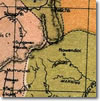
Pastoral Station entry
| Home | Browse | Search | Previous | Next |

|
Unlocking Regional Memory
Pastoral Station entry
|
|
Inverell Station |
||
|
|
Inverell Station, situated in northern New South Wales several kilometres north of the present-day city of the same name, was taken up by Alexander Campbell in 1842. Campbell, born about 1792 in Argyleshire, Scotland, had migrated to Australia in 1825 as one of five overseers for Peter Macintyre, of Blairmore, Aberdeen, on the Hunter River. Macintyre was by this time a very wealthy grazier, and after receiving first-hand information on the Inverell region from his friend, Allan Cunningham, who had explored the area in 1827 and praised its ‘beautiful sward of grass’, the wily Scotsman looked to occupying the land before it was appropriated by someone else. In 1835, he despatched Campbell (now a superintendant) to examine the unexplored country of New England. Campbell first claimed a large tract of land for Macintyre at Guyra (Gyra), then proceeded west to the present site of Bundarra. While camped on the Gwydir River, he was informed by local Aborigines of a ‘Cawbawn Kallie’, or great river, further north. This confirmed Cunningham’s account, and thus encouraged, Campbell set out with his party shortly thereafter. The extensive plains and lush pastures they found there induced Campbell to immediately mark out the boundaries of a cattle station for Peter Macintyre, which he named Byron Plains (not after the poet, as is commonly believed, but after a member of the search party, Peter Byron). Campbell then returned to Blairmore, where he married Catherine MacIntyre (no relation of Peter) and continued to administer Macintrye’s Hunter Valley property. When in 1842 Peter Macintyre died, his sister, Mary, inherited Byron Plains and placed it under the care of Campbell. While there he established his own station directly east of Byron Plains which he called Inverell Station. The name he chose for the property, which was later given to the settlement nearby, is a Gaelic word which derives from Campbell’s native Inverawe in Scotland; ‘inver’, meaning confluence (referring to the confluence of the Macintyre River and Swan Brook on his property), and ‘ell’, meaning swan (referring, of course, to Swan Brook, although Macintyre is reported to have seen several swans there as well). Unlike Byron Plains, which had been established as a cattle station, Inverell was specifically set up as a sheep run. By 1845, Campbell’s property of 50,000 acres carried 11,100 sheep but only 24 cattle. He immediately built a homestead for his young family (Alexander and Catherine would have eight children, the first of whom, Elizabeth, came with them to Inverell in 1842), which Campbell situated alongside Swan Brook. He and his wife spent considerable time tending to their property, and within a decade it was the central show place for the north. Its Merino sheep became famous throughout the colony for their consistently high quality. Nevertheless, life on Inverell Station was arduous and difficult; in the early years at least, the property was terribly isolated, and there was the constant fear of attacks from the Aborigines whose land was being encroached upon; ‘of roads and fences there were none’, as EC Sommerlad later wrote; ‘supplies and mails came tortuously overland from distant Morpeth - Medical advice when needed involved a preliminary journey of hundreds of miles over the mountains; of law, as represented by Crown authority, nothing was known. In 1858, Campbell died, leaving Catherine to run the station. Their eldest son, Peter, was then only fourteen, so she appointed a manager until he reached manhood. In 1864, Peter Colin Campbell at the early age of twenty assumed responsibility for Inverell Station. A person of indefatigable energy, he formed the property into a firm called Campbell Brothers (though it also included the three sisters), introduced an extensive land-clearing and fence-building program, built a new woolshed (1870) capable of accommodating eighteen shearers at a time, and established a very successful Hereford, Merino and Clydesdale stud. He married Dora Clerk, daughter of Edward and Mary Clerk of Clerkness, near Bundarra, and in 1889 built a new homstead - which he called Weranga - overlooking the original slab hut. At its peak, Inverell Station under Peter Campbell’s able management carried 100,000 sheep, 4,000 head of cattle and up to 200 pure-bred Clydesdales. He also developed a new strain of Merino sheep by breeding Inverell ewes with Rambouillet rams imported direct from France. During his stewardship of the property, Peter Campbell bought about 4,000 acres of free-hold land around the homestead but little else. As a result, Inverell Station was gradually reduced in size during the late-nineteenth and early-twentieth centuries. A portion of its southern boundary had already been appropriated, around 1860, to establish the township of Inverell, but it was not until 1910 that large sections of the estate were subdivided. In 1923, after Peter Campbell’s death, responsibility for Inverell Station passed to his son, Colin. The property was further reduced in 1946, when large sections of Inverell Station were cut up for soldier settler blocks. Now managed by the Body family, fourth-generation descendants of Alexander Campbell, Inverell Station with an area of 3,600 acres concentrates mainly on cattle-rearing and general agriculture. Related Bodies:
| |
| |
Related Pastoral Stations | |
| Top of Page | |
|
|
| ||
|
Published by The Australian Science and Technology Heritage Centre, 5 April 2004 Prepared by: Acknowledgements Updated: 23 February 2010 http://www.nswera.net.au/biogs/UNE0223b.htm |